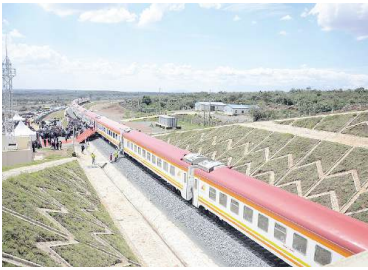

The two, if done ahead of the 2027 polls, would effectively become political game changers for Ruto in the Western region.
Ruto has on many occasions reiterated that the SGR extension remains his top infrastructure ambition.
In September 2024, Ruto said the extension of the SGR into the region and the Rironi-Mau Summit-Eldoret-Malaba dual carriageway are Kenya's top priorities in the engagement with China. He was meeting a Chinese delegation.
The President said the expansion of the SGR from Naivasha to Uganda, Rwanda, DR Congo and Congo Brazzaville would connect the Indian Ocean and the Atlantic Ocean. This converges with China’s Belt and Road Initiative ambition.
The Rironi-Mau Summit-Malaba highway, as would be the SGR line to Malaba, is a corridor for passengers and goods to Western Kenya and the EAC region.
In a final push to secure funding for the SGR, Ruto on Tuesday dispatched Treasury CS John Mbadi to Beijing for “high-level bilateral talks”.
Mbadi’s delegation comprises Treasury PS Chris Kiptoo, Council of Economic Advisers chairman David Ndii, council member Mohammed Hassan and Public Debt Management Office director general Raphael Owino.
The CS on Wednesday held talks with China's Finance Minister Lan Fo'an and Exim Bank Vice President Yang Dongning. He said the meeting explored potential areas of collaboration to help unlock Kenya's economic fortunes.
The trip adds to the several high-level visits to China, including by the President, seeking to unlock financing for the SGR extension.
Amidst financial constraints, Ruto has also explored additional funding for the SGR from other allies.
On January 14, during an official visit to the UAE, the President announced Kenya was exploring a partnership agreement with the UAE to facilitate the railway extension.
The UAE funding, if secured, is expected to cover for the balance the Chinese will not cover.
Mbadi on March 27 told the Budget and Appropriation Committee that Kenya would source 30 per cent of the SGR financing externally and another 30 per cent locally.
“The remaining 40 per cent will be sourced from a consortium of Chinese companies who will recoup the money through tolls,’’ Mbadi said.
China-Africa development cooperation specialist Dr Adhere Cavince says China remains the most promising development partner for Kenya, especially in developing infrastructure that can reboot economic activities.
“The prospects of the SGR extension and construction of Rironi-Mau Summit projects with Chinese support is welcome,” Dr Cavince told the Star.
“China has demonstrated willingness to put capital and technology in partner countries like Kenya.”
He added that the rapid infrastructure modernisation under President Uhuru Kenyatta led to Kenya emerging as one of the most successful countries in BRI implementation.
“The SGR extension and the Mau Summit road will dramatically enhance access to Western Kenya, foster sustainability of the railway and mobility of people and goods,” Cavince said.
The construction of the road is expected to start in June after the Cabinet approved its dualling to a four-lane highway in March. The 170km road is expected to take 24 months to complete.
In December, Ruto also pledged to dual the Naivasha-Nakuru highway to Malaba by 2027 through a Public-Private Partnership, following a heavy traffic deadlock during the festive period.
“The commitment I want to give to you is that next year, we will begin the construction of a dual carriageway from Nairobi, first to Nakuru and then from Nakuru later, we will take it to Malaba,” Ruto said in Eldoret.
To manoeuvre the cash constraints the country is facing, Cavince says a PPP model with China offers an option to finance the projects.
“To reduce the pressure on existing public resources, Kenya and China are now increasingly thinking of engaging in PPPs that can allow construction of infrastructure without adding public debt,” he adds.
He said the model is being explored in the extension of the SGR, where Kenya is expected to raise 60 per cent of the needed resources, while 40 per cent will come from China.
Political commentator Dismas Mokua says that if the President succeeds in doing the road project, it would be an economic game changer for Western region. Whether it gives him votes is an entirely different conversation, however, he says.
“The project is long overdue as it ought to have been a priority project as soon as Kenya gained Independence in 1963,” Mokua said.
“Having Western with huge economic potential but lacking necessary infrastructure is unacceptable. It undermines regional trade.”
With such a road in place, even farmers from Kisii would be able to transport goods to Nairobi in just four hours compared to the eight it currently takes, he said.
Third President Mwai Kibaki is widely remembered for the 50km Thika Road superhighway from Nairobi to Thika, a project that opened up the Central region to the capital.
The construction of the Sh32 billion road started in Kibaki’s second term in January 2009 and ended in November 2012 just as he was retiring.
Ruto’s predecessor Uhuru’s legacy projects are largely the SGR from Mombasa to Nairobi and Naivasha, the Nairobi Expressway and bypasses in Nairobi, Kisumu and Mombasa cities.
The Mombasa and Nairobi section was built between October 2016 and January 2018, a critical political period as Uhuru sought his second term.





![[PHOTOS] Gachagua warm reception in Nyandarua](/_next/image?url=https%3A%2F%2Fcdn.radioafrica.digital%2Fimage%2F2025%2F04%2Fc2a8c64d-5577-4768-a0ac-513c8876c288.jpeg&w=3840&q=100)





![[PHOTOS] Guardian Angel bus catches fire in Kikuyu](/_next/image?url=https%3A%2F%2Fcdn.radioafrica.digital%2Fimage%2F2025%2F04%2F58287f0a-f201-4a78-87f0-6f147ad8ba8a.jpg&w=3840&q=100)
